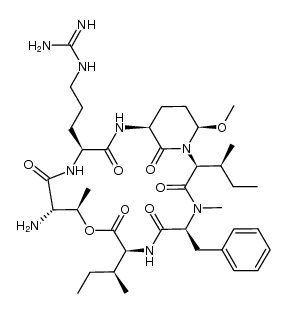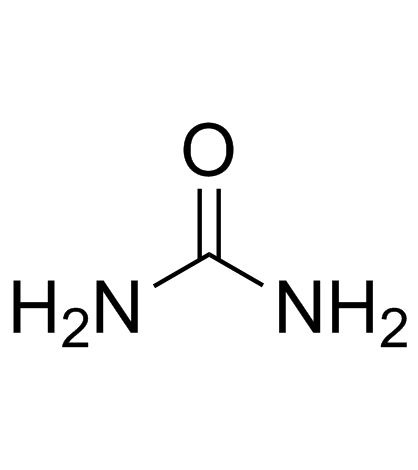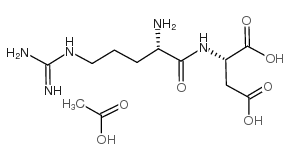1119-34-2
| Name | 2-Amino-5-guanidinovaleric acid monohydrochloride |
|---|---|
| Synonyms |
(+)-L-arginine hydrochloride
Arginine, hydrochloride, L- (2S)-2-amino-5-carbamimidamidopentanoic acid hydrochloride levargin L-Arginine HCl L-(+)-Arginine monohydrochloride L-Arginine hydrochloride L-ARG HCL (S)-2-Amino-5-guanidinopentanoic acid hydrochloride (S)-(+)-Arginine hydrochloride,L-Arginine hydrochloride L-Arginine hydrochloride (1:1) (S)-(+)-2-Amino-5-[(aminoiminomethyl)amino]pentanoic acid monohydrochloride 2-Amino-5-guanidinovalericacidmonohydrochloride anhydrous L-arginine monohydrochloride L-Arginine HCl (L-Arg) Arginine hydrochloride L-Arginine.HCl Arginine Muriate S-(+)-2-Amino-5-[(aminoiminomethyl)amino]pentanoic acid monohydrochloride (S)-arginine hydrochloride L(+)-Arginine hydrochloride ARG,HCL (2S)-2-Amino-5-carbamimidamidopentansäurehydrochlorid L-Arginine, hydrochloride (1:1) EINECS 214-275-1 L-Arginine Monohydrochloride (VAN) 2-Amino-5-guanidinovaleric ac detoxargin r-gene Arginine HCL argivene MFCD00064550 H-Arg-OH.HCl L-arginine, hydrochloride acide (2S)-2-amino-5-carbamimidamidopentanoïque chlorhydrate L-Arginine monohydrochloride minophagena L-Arginine (hydrochloride) |
| Description | L-Arginine is the nitrogen donor for synthesis of nitric oxide, a potent vasodilator that is deficient during times of sickle cell crisis.Target: OthersArginine is an α-amino acid. It was first isolated in 1886. The L-form is one of the 20 most common natural amino acids. At the level of molecular genetics, in the structure of the messenger ribonucleic acid mRNA, CGU, CGC, CGA, CGG, AGA, and AGG, are the triplets of nucleotide bases or codons that code for arginine during protein synthesis. In mammals, arginine is classified as a semiessential or conditionally essential amino acid, depending on the developmental stage and health status of the individual.L-Arginine is associated with a decrease in cardiac index while stroke index is maintained in patients with severe sepsis. Resolution of shock at 72 hours is achieved by 40% and 24% of the patients in the L-Arginine and placebo cohorts, respectively. L-Arginine (450 mg/kg during a 15-minute period) amplifies and sustains the hyperemia (38%) and increases absolute brain blood flow after eNOS upregulation by chronic simvastatin treatment (2 mg/kg subcutaneously, daily for 14 days) in SV-129 mice. |
|---|---|
| Related Catalog | |
| References |
[1]. Tapiero H, et al. I. Arginine. Biomed Pharmacother. 2002 Nov;56(9):439-45. |
| Density | 1.42 |
|---|---|
| Boiling Point | 409.1ºC at 760 mmHg |
| Melting Point | 226-230 °C(lit.) |
| Molecular Formula | C6H15ClN4O2 |
| Molecular Weight | 210.662 |
| Flash Point | 201.2ºC |
| Exact Mass | 210.088348 |
| PSA | 125.22000 |
| LogP | 1.35480 |
CHEMICAL IDENTIFICATION
HEALTH HAZARD DATAACUTE TOXICITY DATA
|
| Personal Protective Equipment | dust mask type N95 (US);Eyeshields;Gloves |
|---|---|
| Hazard Codes | Xi: Irritant; |
| Risk Phrases | R36/37/38 |
| Safety Phrases | S37/39-S26-S24/25 |
| RIDADR | NONH for all modes of transport |
| WGK Germany | 2 |
| RTECS | CF1995500 |
| HS Code | 2922499990 |
| Precursor 6 | |
|---|---|
| DownStream 10 | |
| HS Code | 2922499990 |
|---|---|
| Summary | HS:2922499990 other amino-acids, other than those containing more than one kind of oxygen function, and their esters; salts thereof VAT:17.0% Tax rebate rate:9.0% Supervision conditions:AB(certificate of inspection for goods inward,certificate of inspection for goods outward) MFN tariff:6.5% General tariff:30.0% |













![Bufa-20,22-dienolide,3-[[8-[[(1S)-4- [(aminoiminomethyl)amino]-1-carboxybutyl]- amino]-1,8-dioxooctyl]oxy]-14-hydroxy-,(3â,- 5â)- structure](https://image.chemsrc.com/caspic/099/35455-33-5.png)



